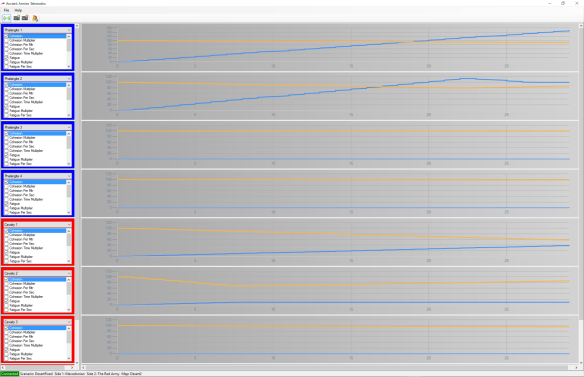Last week I alluded to having to write a new telematics system for Ancient Armies.
Well, it’s now here, mostly….
The screenshot above was taken from the new telematics application. It can connect to any game running on any networked machine and provide real-time graphical detail with regards to the multitude of hidden variables within the game.
Below is a screenshot of the game that was sending its data:
You will need the eyes of an eagle-hawk, but the only noticeable difference between this game window and the older ones is the new telematics button on the far right of the main toolbar.
This button is normally hidden by default. To show it and gain the use of telematics one must first go to the options screen and pop across to the new Telematics tab:
This tab allows one to enable telematics and to pick the machine that the telematics application resides on. I have greyed out my machine names as I don’t want the internet to know the names of my local computers.
Once enabled, the telematics button becomes available on the main menu. Simply click this to allow the automatic sending of data.
If the telematics application is not running whilst the game is sending data, this is not an issue. The system will simply wait for the telematics application to start then automatically send the backlog of telematics data. In the meantime, one can carry on playing!
This new feature brings a lot to the table. Firstly, I can now see what’s happing in every unit on the battlefield, all in realtime! Being able to see their variables changing over time allows me to spot bugs easily and to check that the modelling is working as expected.
In fact this system has already found its first issue. If you look at the first screenshot at the top of this post you will see the cohesion (orange) and fatigue (blue) levels for all the units in the scenario over the first turn.
One thing I noticed is that for some orders, the units were not recovering from their exertions. Such an issue would have been very difficult to spot without this tool and may well have gone unnoticed whilst introducing many subtle issues.
The other thing that this system brings to the table is Hermes.
What’s Hermes?
Hermes is my new communications layer for the game. In fact, like Chronos and Atlas before it, it has been made generic enough that it can be used for any game or program.
The best thing about Hermes is that it hides the complexities of low level communications thus making it very easy to use. It also allows one to use a variety of low level protocols (simply inject them in), all whilst presenting developers with the same simple to use interface.
As expected, Hermes also handles all the other issues normally associated with communications, such as multi-threading and queuing. All in all, a very powerful system. 😎
In terms of the game itself, having Hermes in place means that multiplayer gaming is now a possibility – I just need make use of the technology that is now there!
However, there is still more work to do on the telematics system. My expectation is that I will be finished by the end of next week.
In fact my JIRA system says that I have just over a day’s worth of additional development to do – assuming my estimating was good. That’s after having invested nearly 4 days of effort into this system – 4 days well spent in my book.
I’ll leave you with a video showing how this new system works. Enjoy!
Laters
RobP




